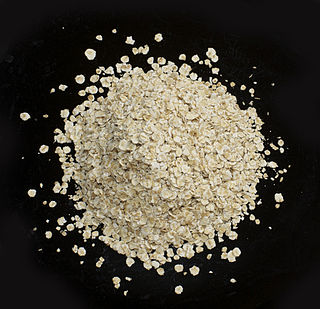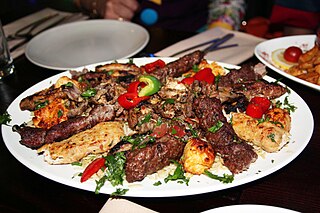
Dessert is a course that concludes a meal. The course consists of sweet foods, such as cake, biscuit, ice cream and possibly a beverage such as dessert wine and liqueur. Some cultures sweeten foods that are more commonly savory to create desserts. In some parts of the world there is no tradition of a dessert course to conclude a meal.

Grits are a type of porridge made from coarsely ground dried maize or hominy, the latter being maize that has been treated with an alkali in a process called nixtamalization, with the pericarp removed. Grits are cooked in warm salted water or milk. They are often served with flavorings as a breakfast dish. Grits can be savory or sweet, with savory seasonings being more common. Grits are similar to other thick maize-based porridges from around the world, such as polenta and mieliepap. The dish originated in the Southern United States but is now available nationwide. Grits are often part of a dinner entrée shrimp and grits, served primarily in the Southern United States.

Cooking bananas are a group of starchy banana cultivars in the genus Musa whose fruits are generally used in cooking. They are not eaten raw and generally starchy. Many cooking bananas are referred to as plantains or 'green bananas'. In botanical usage, the term "plantain" is used only for true plantains, while other starchy cultivars used for cooking are called "cooking bananas". True plantains are cooking cultivars belonging to the AAB group, while cooking bananas are any cooking cultivar belonging to the AAB, AAA, ABB, or BBB groups. The currently accepted scientific name for all such cultivars in these groups is Musa × paradisiaca. Fe'i bananas from the Pacific Islands are often eaten roasted or boiled, and are thus informally referred to as "mountain plantains", but they do not belong to any of the species from which all modern banana cultivars are descended.

In the United States, pigs in a blanket are small hot dogs or other sausages individually wrapped in pastry, commonly served as an appetizer.

Oatmeal is a preparation of oats that have been de-husked, steamed, and flattened, or a coarse flour of hulled oat grains (groats) that have either been milled (ground), rolled, or steel-cut. Ground oats are also called white oats. Steel-cut oats are known as coarse oatmeal, Irish oatmeal, or pinhead oats. Rolled oats were traditionally thick old-fashioned oats, but they can be made thinner or smaller and may be categorized as quick oatmeal or instant oatmeal depending on the cooking time required, which is determined by the size of the oats and the amount of precooking.

A crêpe or crepe is a dish made from unleavened batter or dough that is cooked on a frying pan or a griddle. Crêpes are usually one of two varieties: sweet crêpes or savoury galettes. They are often served with a wide variety of fillings such as cheese, fruit, vegetables, meats, and a variety of spreads. Crêpes can also be flambéed, such as in crêpes Suzette.

Pakistani cuisine can be characterized as a blend of regional cooking styles and flavours from across South, Central and Western Asia. Pakistani cuisine is influenced by Persian, Indian, and Arab cuisine. The cuisine of Pakistan also maintains certain Mughal influences within its recipes and cooking techniques. Pakistan's ethnic and cultural diversity, diverse climates, geographical environments, and availability of different produce lead to diverse regional cuisines.

Semolina is the name given to coarsely milled durum wheat mainly used in making pasta and sweet puddings. The term semolina is also used to designate coarse millings of other varieties of wheat, and sometimes other grains as well.

Latin American cuisine is the typical foods, beverages, and cooking styles common to many of the countries and cultures in Latin America. Latin America is a highly racially, ethnically, and geographically diverse with varying cuisines. Some items typical of Latin American cuisine include maize-based dishes arepas, empanadas, pupusas, tacos, tamales, tortillas and various salsas and other condiments. Sofrito, a culinary term that originally referred to a specific combination of sautéed or braised aromatics, exists in Latin American cuisine. It refers to a sauce of tomatoes, roasted bell peppers, garlic, onions and herbs. Rice, corn, pasta, bread, plantain, potato, yucca, and beans are also staples in Latin American cuisine.

Croatian cuisine is heterogeneous and is known as a cuisine of the regions, since every region of Croatia has its own distinct culinary tradition. Its roots date back to ancient times. The differences in the selection of foodstuffs and forms of cooking are most notable between those in mainland and those in coastal regions. Mainland cuisine is more characterized by the earlier Slavic and the more recent contacts with Hungarian, German and Turkish cuisine, using lard for cooking, and spices such as black pepper, paprika, and garlic. The coastal region bears the influences of Greek and Roman cuisine, as well as of the later Mediterranean cuisine, in particular Italian. Coastal cuisines use olive oil, herbs and spices such as rosemary, sage, bay leaf, oregano, marjoram, cinnamon, clove, nutmeg, and lemon and orange rind. Peasant cooking traditions are based on imaginative variations of several basic ingredients and cooking procedures, while bourgeois cuisine involves more complicated procedures and use of selected herbs and spices. Charcuterie is part of the Croatian culinary tradition in all regions. Food and recipes from other former Yugoslav countries are also popular in Croatia.

Arepa is a type of flatbread made of ground maize dough stuffed with a filling, eaten in northern parts of South America since pre-Columbian times, and notable primarily in the cuisine of Colombia and Venezuela, but also present in Bolivia, Ecuador, and Central America.

Hallaca is a traditional Venezuelan dish. Its origin is indigenous, but raisins, capers, olives, and sometimes bits of bacon were added in the 16th Century and after by settlers from the Iberian peninsula. Hallaca consists of corn dough stuffed with a stew of beef, pork, or chicken and other ingredients such as raisins, capers, and olives, fresh onion rings, red and green bell pepper slices. There are vegetarian hallacas, made with black beans or tofu. Hallacas are folded in plantain leaves, tied with strings, and boiled. The dish is traditionally served during the Christmas season and has several regional variants. It has been described as a national dish of Venezuela. Some speculate it originated from the Orinoquia. Characteristic of the hallaca is the delicate corn dough made with consommé or broth, and lard colored with annatto. Hallacas are also commonly eaten in eastern Cuba, Trinidad where it is called pastelle, and parts of Colombia, Ecuador, Aruba, and Curaçao.

Sopa de mondongo is a soup that originally came from Colombia and the Dominican Republic. It is made from diced tripe slow-cooked with vegetables such as bell peppers, onions, carrots, cabbage, celery, tomatoes, cilantro, garlic or root vegetables. The dish is generally prepared in former Spanish colonies in Latin America, Caribbean, and in the Philippines. The proposed etymology for mondongo is in the African Kikongo language, meaning “intestines, entrails of certain animals.

A platter is a large type of dishware used for serving food. It is a tray on which food is displayed and served to people. Its shape can be oval, round, octagonal, rectangular, or square. It can be made of metal, ceramic, plastic, glass or wood. Plain and ornate platters suitable for more formal settings or occasions are made of, or plated with, silver, and antique examples are considered quite valuable. Especially expensive and ceremonial platters have been made of gold.

Colombian cuisine is a culinary tradition of the six main regions within Colombia. Colombian cuisine varies regionally and is influenced by Indigenous Colombian, Spanish, and African cuisines, with a slight Arab influence in some regions.

Bandeja paisa, with variations known as bandeja de arriero, bandeja montañera, or bandeja antioqueña, is one of the most representative meals in Colombian cuisine, especially of the Antioquia department and the Paisa Region, as well as with the Colombian Coffee-Growers Axis. Paisa refers to a person from the Paisa Region and bandeja is Spanish for platter.

Hogao is a variant of Spanish sofrito and is typically used in Colombian cuisine. Traditionally made with only long green onions and tomatoes, differing from guiso, which can also be made with round onions, garlic, cumin, salt, and pepper that are sauteed over low heat during the cooking process. It is used for meats, arepas, rice, and other dishes, and can complement the famous bandeja paisa. The ingredients and naming tradition varies from region to region, though it is originally from Antioquia and the region whose people are known as paisa. Its name comes from the old use of the verbs ahogar and rehogar that reference a slow cooking technique.

Mazamorra or masamorra is the name for numerous traditional dishes from the Iberian Peninsula and Hispanic America.

Italian meal structure is typical of the European Mediterranean region and differs from that of Northern, Central, and Eastern Europe, although it still often consists of breakfast (colazione), lunch (pranzo), and supper (cena). However, breakfast itself is often skipped or is lighter than that of non-Mediterranean Europe. Late-morning and mid-afternoon snacks, called merenda, are also often eaten.



















